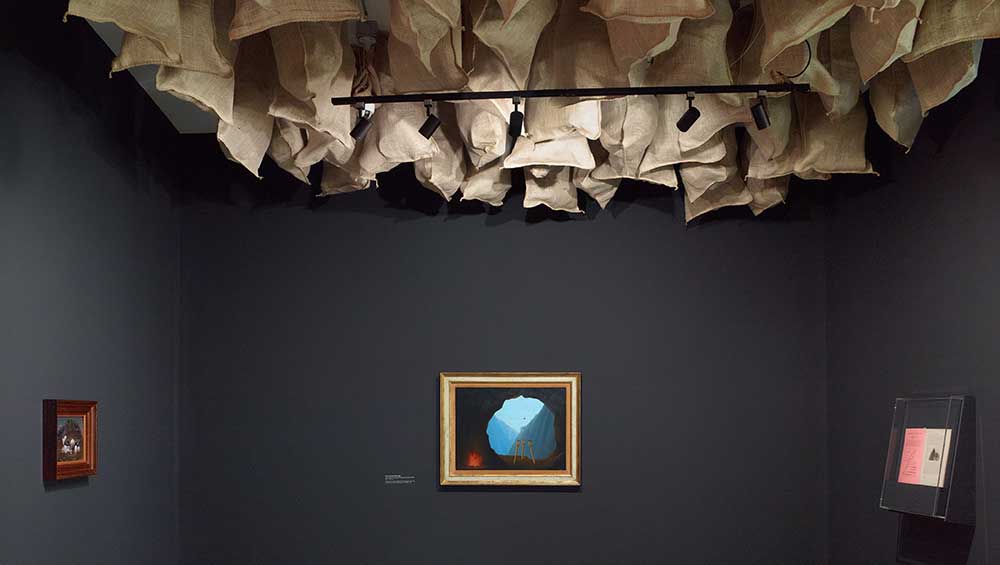
Forbidden Territories: 100 Years of Surreal Landscapes, Installation view, Hepworth Wakefield, November 2024. Photo: Michael Pollard, courtesy The Hepworth Wakefield.
The Hepworth Wakefield
23 November 2024 – 21 April 2025
by DAVID TRIGG
Suspended above our heads at the entrance to Forbidden Territories: 100 Years of Surreal Landscapes are what purport to be numerous sacks of coal – an homage to Marcel Duchamp’s installation at the 1938 International Surrealist Exhibition at Galérie Beaux-Arts, Paris. The French artist’s sacks were stuffed with newspaper and coal dust, which leaked on to unsuspecting visitors. In the darkened space at the Hepworth Wakefield it is unclear what the hessian bags are filled with, though there are no signs of any escaping powder. Beneath them, amid spotlit artworks by Max Ernst, René Magritte and ELT Mesens, hangs André Breton’s Surrealist Manifesto of 1924, the document that 100 years ago spawned one of the 20th century’s most radical art movements and which has inspired this expansive exhibition exploring surreal landscapes from the 1920s to the present day.
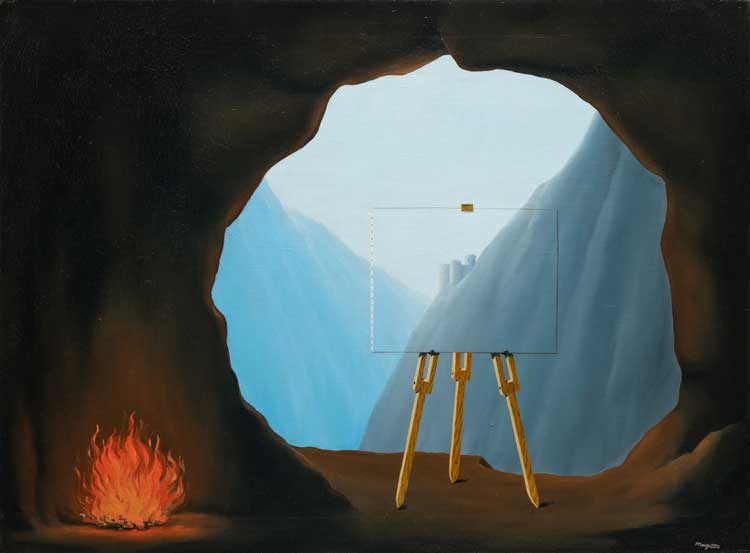
René Magritte. La Condition Humaine, 1935. © ADAGP, Paris and DACS, London. Norwich Castle Museum and Art Gallery (Norfolk Museum Service).
Throughout Forbidden Territories, deserts, forests, beaches and mountains become sites for the exploration of subconscious desires, dreams and irrationality. A whole room is dedicated to bodies of water – oceans, rivers and lakes – and the surrealist visions they have inspired. Dredged up from the depths of her psyche, Marion Adnams’ fantastical Alter Ego (1945) depicts a doll-like woman, seemingly made from paper, standing on a shore alongside the upright skeleton of an impossibly large bird. Like Adnams, Edith Rimmington also drew inspiration from objects that had washed up on the beach, though her photographs revel not in fantasy but in the strangeness of the observable world. Her untitled seashore photographs, made towards the end of her life, depict driftwood and rocks half-buried in the sand. Appearing like unearthed body parts or strange growths, these closely cropped and intentionally ambiguous images transform the ordinary into uncanny, even macabre scenes.
-photo-Rob-Battersby.jpg)
Ro Robertson, Interlude II, 2024. Installation view, Hepworth Wakefield, November 2024. Photo: Rob Battersby
Adnams’ and Rimmington’s works are shown alongside paintings by Eileen Agar and Ithell Colquhoun, photographs by Claude Cahun and Dora Maar, and collages by María Berrío. Overshadowing them all, however, is Ro Robertson’s sprawling painted metal sculpture Interlude II (2024), which is informed by the artist’s experiences of experimenting with automatic drawing on Porthmeor Beach in St Ives. The work’s twisted steel forms evoke the rhythmic motion of ocean waves and, in this context, the mangled aircraft dump that Paul Nash (an artist conspicuously absent from this show) transformed into a surreal sea of wreckage in his masterful 1940 canvas Totes Meer.
Transhistorical groupings continue in the next room, where the contemporary Swiss artist Nicolas Party has created a large pastel mural directly on to the wall. Depicting a variegated conglomeration of trees rendered with a childlike palette of bright colours akin to the decor of a child’s nursery, it provides an incongruous backdrop to Max Ernst’s brooding forest painting Cage, Fôret et Soleil Noir (Cage, Forest and Black Sun, 1927), which has been hung directly on top of it. Here, a dark wall of tree-like forms partially obscures a mysterious disk while, in the foreground, a blue-eyed bird is trapped in a cage.

Pastel mural by Nicolas Party with Max Ernst’s Cage, Fôret et Soleil Noir (Cage, Forest and Black Sun, 1927). Installation view, Hepworth Wakefield, November 2024. Photo: Michael Pollard, courtesy The Hepworth Wakefield.
The rationale for this pairing lies in the fact that both artists draw on childhood memories of landscape: Ernst wrote about the dense Bavarian woodland near his family home, while Party remembers with fondness his upbringing on the shores of Lake Geneva overlooked by alpine forests. The juxtaposition recalls Ernst’s 1934 description of collage as “the fortuitous meeting of two distant realities on an inappropriate plane”, which Breton himself once quoted to describe the essence of the surrealist method.
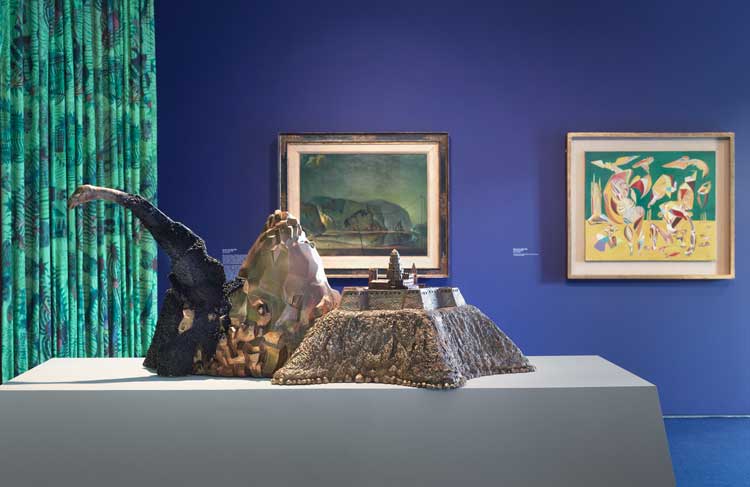
Wael Shawky, The Gulf Project Camp: Sculpture # 1, 2019. Installation view, Hepworth Wakefield, November 2024. Photo: Michael Pollard, courtesy The Hepworth Wakefield.
Elsewhere, two bronze sculptures from Wael Shawky’s The Gulf Project Camp series (2019) are shown alongside works by Salvador Dalí and Lee Miller. In Sculpture #4, a mountain landscape has apparently sprouted insect-like legs, while Sculpture #1 depicts a golden hilltop fort dwarfed by a bizarre chimeric protrusion. These eccentric landscapes relate to Shawky’s Gulf Project film series, which explores histories of conflict in Egypt and the Arabian Gulf. This theme is underscored by Dalí’s Mountain Lake (1938), which reimagines a lake near the Pyrenees that was visited by Dalí’s parents after his brother’s death: a disconnected telephone receiver supported by crutches alludes to Neville Chamberlain’s failed negotiations with Hitler in the prelude to the second world war, a reflection of the political and social tensions in Europe during the late 1930s.
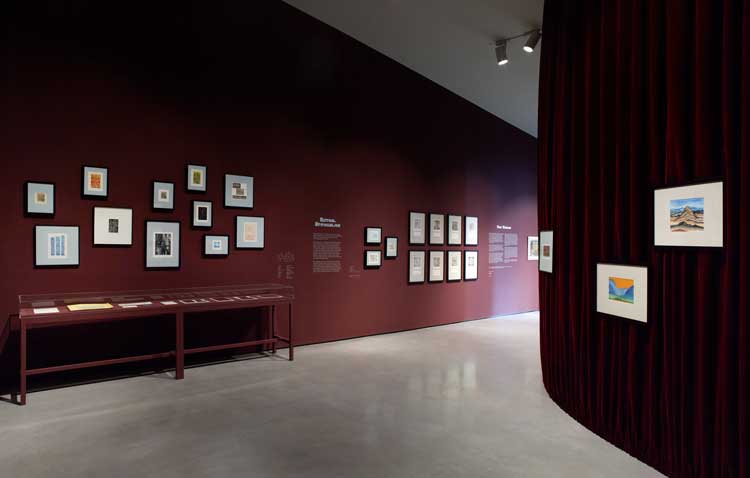
Works by Mary Wykeham. Installation view, Hepworth Wakefield, November 2024. Photo: Michael Pollard, courtesy The Hepworth Wakefield.
Forbidden Territories is a beautifully installed, if occasionally bloated exhibition. Snaking through the galleries is a patterned curtain designed by Aliyah Hussain, which provides a backdrop for paintings by Pablo Picasso and Francis Picabia. Behind one section of curtain is a substantial solo presentation by the British artist Mary Wykeham (1909-96), a remarkable yet largely forgotten figure who wrestled to reconcile her commitment to art with a religious calling. In the mid-1930s, she travelled to Paris where she attended Stanley William Hayter’s print studio Atelier 17, which was frequented by many surrealists, including Jean Arp, Yves Tanguy and Joan Miró. Under Hayter’s tutelage, Wykeham learned burin engraving and experimented with automatic surrealist techniques, creating semi-abstract prints characterised by undulating and coiling lines. In 1949, she shocked the art world by becoming a nun, a decision that put her firmly at odds with the surrealists, whose antipathy towards any form of spiritual belief was fomented by Breton himself.
Feeling like a show within a show, Wykeham’s display – her largest since 1949 – is the result of a recent donation to the Hepworth Wakefield, though whether Forbidden Territories is the most suitable context for it is questionable. While the terrains of Sicily and Saharan Algeria stimulated several works here – notably the etchings Dream Desert (1979) and Sahara – Hoggar (1991) – others, such as the artist’s portfolio of engravings illustrating a 17th-century book on Chinese Taoist meditation, can hardly be considered landscapes. Though if sacks of “coal” suspended from the ceiling constitute a terrain, it is perhaps conceivable that Wykeham’s abstract twisting and sinuous vortices do too.

Installation view, Hepworth Wakefield, November 2024. Photo: Michael Pollard, courtesy The Hepworth Wakefield.
Indeed, the elastic definition of “landscape” employed by the show’s curators allows for many unexpected inclusions, such as Henry Moore’s Reclining Figure (1936) and Hussain’s large-scale ceramic sculpture Creeper (2024), which appears like a bird-headed Hindu goddess. These are shown in the final room alongside biomorphic sculptures by Jean Arp and Leonora Carrington, which reflect a fascination with botanical studies and the natural world. The vague theme of “biomorphic natures” here becomes a catch-all for all manner of surreal oddities that in any other context would not be classed as landscapes. Yet these are artists who considered nature to be aligned with irrationality and so, in a show dedicated to “the perpetual excursion into the midst of forbidden territories”, as Breton put it, the lack of a rational through-line should come as no surprise.
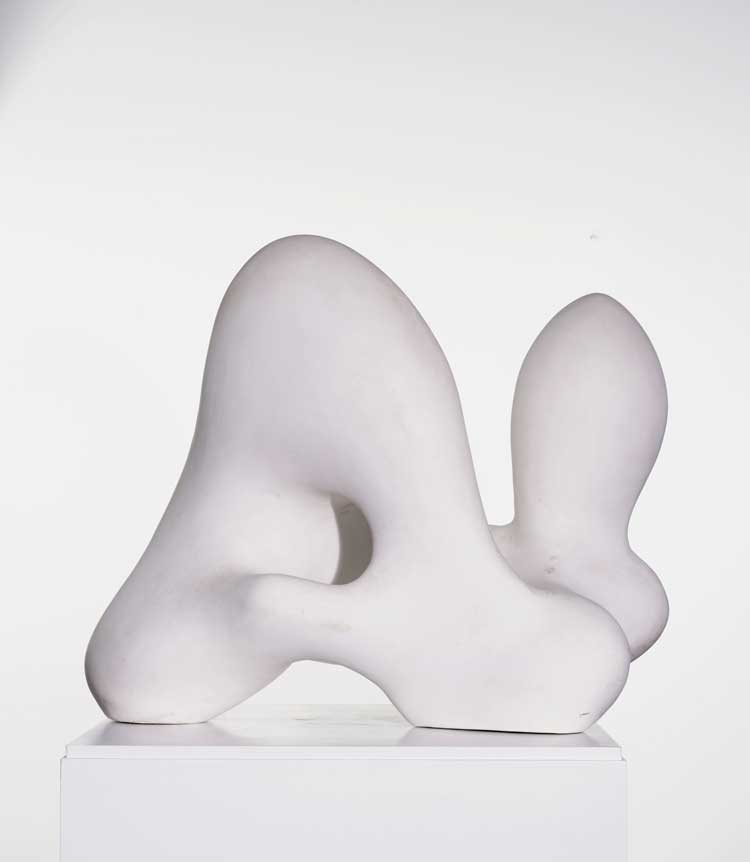
Jean Arp. Landscape or a Woman, 1962. Wakefield Council Permanent Art Collection (The Hepworth Wakefield). Gift offered by the Jean Arp Foundation, 2024. Photo: Rüdiger
Lubricht, Worpswede.